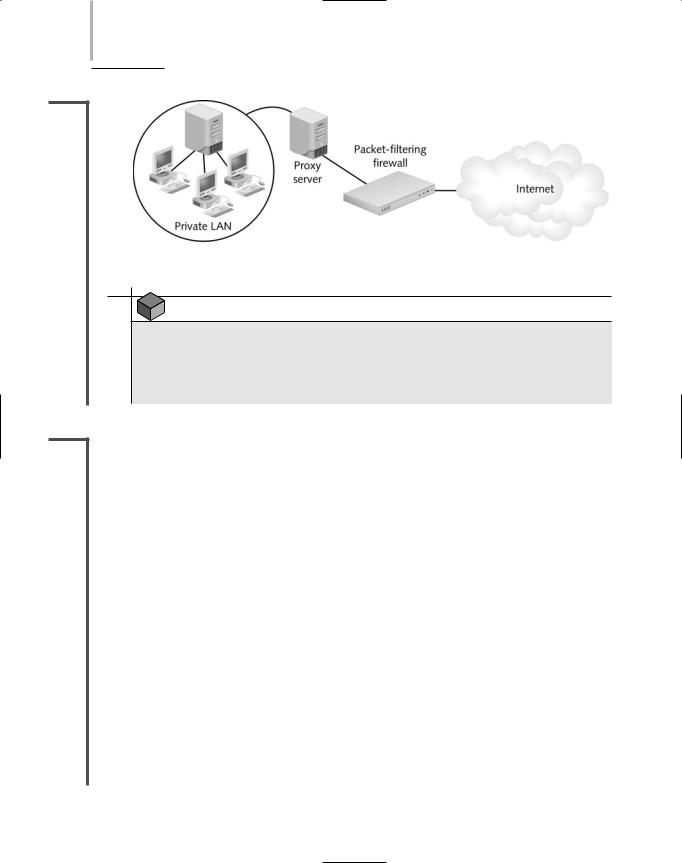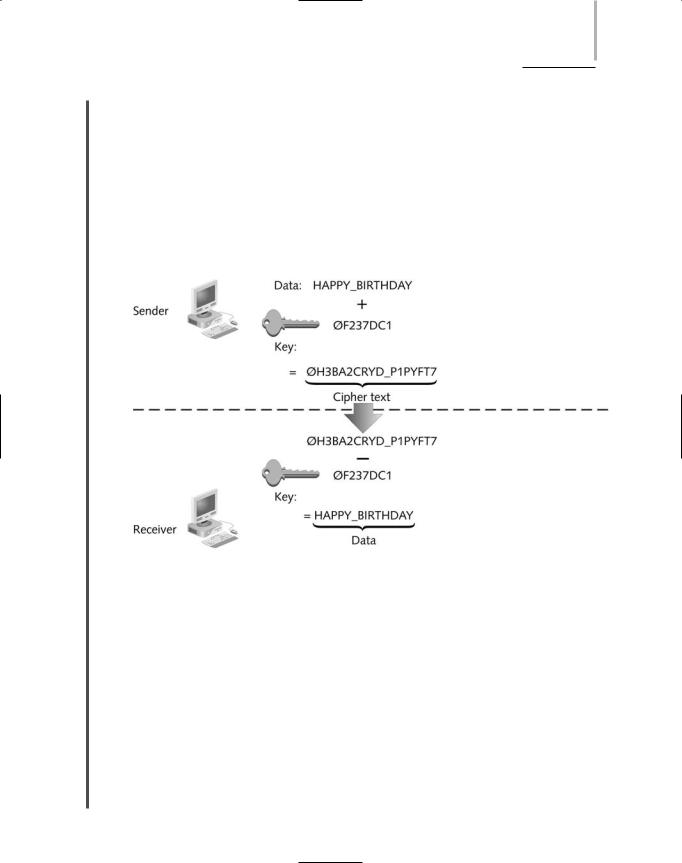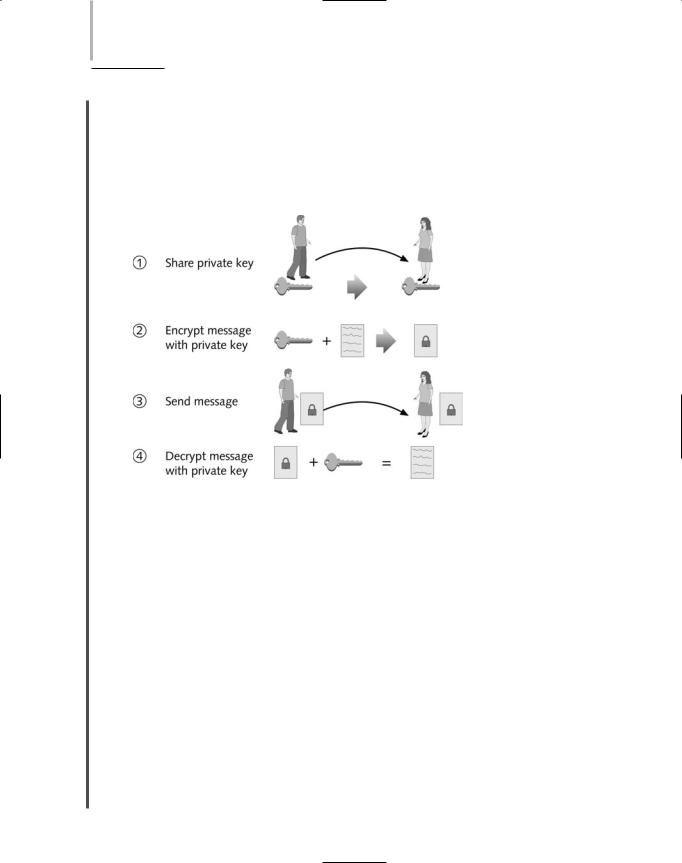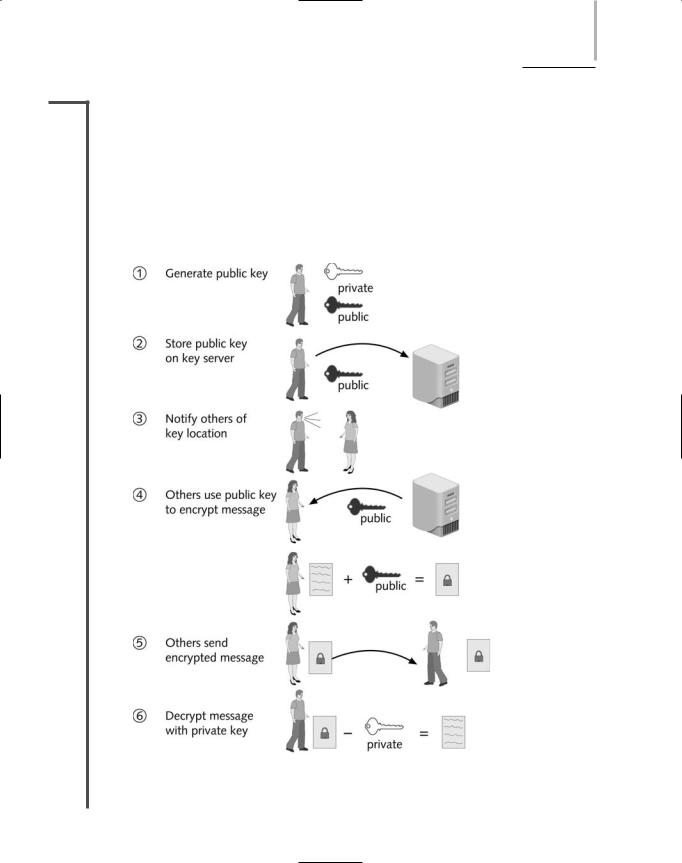
Network Plus 2005 In Depth
.pdf
632 Chapter 14 NETWORK SECURITY
NET+
3.6
3.7
FIGURE 14-4 A proxy server used on a WAN
NOTE
Often, firewall and proxy server features are combined in one device. In other words, you might purchase a firewall and be able to configure it not only to block certain types of traffic from entering your network, but also to modify the addresses in the packets leaving your network.
NET+ Remote Access
3.7As you have learned, many companies supply traveling employees, telecommuters, or distant vendors with remote access to their private LANs or WANs. When working with remote access, you must remember that any entry point to a LAN or WAN creates a potential security risk. In other words, if an employee can get to your network in New York from his hotel room in Rome, a smart hacker can likely do the same. You can, however, take advantage of techniques designed to minimize the possibility of such unauthorized remote access. In this section, you will learn about security measures tailored to remote access solutions, such as remote control and dial-up networking.
Remote Control
Remote control systems enable a user to connect to a host system on a network from a distance and use that system’s resources as if the user were sitting in front of it. Although such remote control systems can be convenient, they can also present serious security risks. Most remote control software programs (for example, Symantec Corporation’s pcAnywhere) offer features that increase the security of remote control systems. If you intend to allow remote control access to a host on your LAN, you should investigate these security features and know how to implement them correctly. Important security features that you should seek in a remote control program include the following:

|
NETWORK OPERATING SYSTEM SECURITY |
Chapter 14 |
|
633 |
|
|
|
||||
|
|
|
|
||
|
A user name and password requirement for gaining access to the host system. |
||||
NET+ |
|||||
3.7The ability of the host system to call back. This feature enables a remote user to dial into the network, enter a user name, and hang up. The host system then calls the user back at a predetermined number (the authorized user’s modem number), thus preventing a hacker from taking over a system even if he obtains the correct user ID and password for the host system.
Support for data encryption on transmissions between the remote user and the system.
The ability to leave the host system’s screen blank while a remote user works on it. This feature prevents people walking by from seeing potentially confidential data.
The ability to disable the host system’s keyboard and mouse. This feature turns the host system into a terminal that responds only to remote users.
The ability to restart the host system when a remote user disconnects from the system. This feature prevents anyone from reviewing what happened during the remote user’s session or gaining access if the session was accidentally terminated before the remote user could properly log off.
Dial-Up Networking
Another method for remote access, dial-up networking, requires users to dial into a remote access server attached to the network. Dial-up networking differs from remote control in that it effectively turns a remote workstation into a node on the network, through a remote access server. When choosing a remote access software package, you should evaluate its security. A secure remote access server package includes at least the following features:
User name and password authentication
The ability to log all dial-up connections, their sources, and their connection times
The ability to perform callbacks to users who initiate connections
Centralized management of dial-up users and their rights on the network
Dial-up network security depends on strict verification of a user’s credentials. Methods of achieving this verification are discussed later in the “Authentication Protocols” section of this chapter.
Network Operating System Security
NET+ |
Regardless of whether you run your network on a Novell, Microsoft, Macintosh, Linux, or |
3.1UNIX network operating system, you can implement basic security by restricting what users are authorized to do on a network. Every network administrator should understand which resources on the server all users need to access. The rights conferred to all users are called public rights, because anyone can have them and exercising them presents no security threat to the


NETWORK OPERATING SYSTEM SECURITY Chapter 14 635
Passwords
Choosing a secure password is one of the easiest and least expensive ways to guard against unauthorized access. Unfortunately, too many people prefer to use an easy-to-remember password. If your password is obvious to you, however, it may also be easy for a hacker to figure out. The following guidelines for selecting passwords should be part of your organization’s security policy. It is especially important for network administrators to choose difficult passwords, and also to keep passwords confidential and to change them frequently.
Tips for making and keeping passwords secure include the following:
Always change system default passwords after installing new programs or equipment. For example, after installing a router, the default administrator’s password on the router might be set by the manufacturer to be “1234” or the router’s model number.
Do not use familiar information, such as your name, nickname, birth date, anniversary, pet’s name, child’s name, spouse’s name, user ID, phone number, address, or any other words or numbers that others might associate with you.
Do not use any word that might appear in a dictionary. Hackers can use programs that try a combination of your user ID and every word in a dictionary to gain access to the network. This is known as a dictionary attack, and it is typically the first technique a hacker uses when trying to guess a password (besides asking the user for her password).
Make the password longer than eight characters—the longer, the better. Some operating systems require a minimum password length (often, eight characters), and some may also restrict the password to a maximum length.
Choose a combination of letters and numbers; add special characters, such as exclamation marks or hyphens, if allowed. Also, if passwords are case sensitive, use a combination of uppercase and lowercase letters.
Do not write down your password or share it with others.
Change your password at least every 60 days, or more frequently, if desired. If you are a network administrator, establish controls through the network operating system to force users to change their passwords at least every 60 days. If you have access to sensitive data, change your password even more frequently.
Do not reuse passwords.
Password guidelines should be clearly communicated to everyone in your organization through your security policy. Although users may grumble about choosing a combination of letters and numbers and changing their passwords frequently, you can assure them that the company’s financial and personnel data is safer as a result. No matter how much your colleagues protest, do not back down from your password requirements. Many companies mistakenly require employees only to use a password, and don’t help them choose a good one. This oversight increases the risk of security breaches.

636 Chapter 14 NETWORK SECURITY
Encryption
NET+ |
Encryption is the use of an algorithm to scramble data into a format that can be read only by |
3.7reversing the algorithm—that is, by decrypting the data. The purpose of encryption is to keep information private. Many forms of encryption exist, with some being more secure than others. Even as new forms of encryption are developed, new ways of cracking their codes emerge, too.
Encryption is the last means of defense against data theft. In other words, if an intruder has bypassed all other methods of access, including physical security (for instance, he has broken into the telecommunications room) and network design security (for instance, he has defied a firewall’s packet-filtering techniques), data may still be safe if it is encrypted. Encryption can protect data stored on a medium, such as a hard disk, or in transit over a communications channel. To protect data, encryption provides the following assurances:
Data was not modified after the sender transmitted it and before the receiver picked it up.
Data can only be viewed by its intended recipient (or at its intended destination).
All of the data received at the intended destination was truly issued by the stated sender and not forged by an intruder.
The following sections describe data encryption techniques used to protect data stored on or traveling across networks.
Key Encryption
The most popular kind of encryption algorithm weaves a key (a random string of characters) into the original data’s bits—sometimes several times in different sequences—to generate a unique data block. The scrambled data block is known as ciphertext. The longer the key, the less easily the ciphertext can be decrypted by an unauthorized system. For example, a 128-bit key allows for 2128 possible character combinations, whereas a 16-bit key allows for 216 possible character combinations. Hackers may attempt to crack, or discover, a key by using a brute force attack, which means simply trying numerous possible character combinations to find the key that will decrypt encrypted data. (Typically a hacker runs an application to carry out the attack.) Through a brute force attack, a hacker could discover a 16-bit key quickly and without using sophisticated computers, but would have difficulty discovering a 128-bit key.
NOTE
Adding 1 bit to an encryption key makes it twice (21 times) as hard to crack. For example, a 129-bit key would be twice as hard to crack than a 128-bit key. Similarly, a 130bit key would be four (22) times harder to crack than a 128-bit key.

ENCRYPTION |
Chapter 14 637 |
NET+ |
The process of key encryption is similar to what happens when you finish a card game, place |
3.7your five-card hand into the deck, and then shuffle the deck numerous times. After shuffling, it might take you a while to retrieve your hand. If you shuffled your five cards into four decks of cards at once, it would be even more difficult to find your original hand. In encryption, theoretically only the user or program authorized to retrieve the data knows how to unshuffle the ciphertext and compile the data in its original sequence. Figure 14-5 provides a simplified view of key encryption and decryption. Note that actual key encryption does not simply weave a key into the data once, but rather inserts the key, shuffles the data, shuffles the key, inserts another copy of the shuffled key into the shuffled data, shuffles the data again, and so on for several iterations.
FIGURE 14-5 Key encryption and decryption
Keys are randomly generated, as needed, by the software that manages the encryption. For example, an e-mail program or a Web browser program may be capable of generating its own keys to encrypt data. In other cases, special encryption software is used to generate keys. This encryption software works with other types of software, such as word-processing or spreadsheet programs, to encrypt data files before they are saved or transmitted.
Private Key Encryption
Key encryption can be separated into two categories: private key and public key encryption. In private key encryption, data is encrypted using a single key that only the sender and the receiver know. Private key encryption is also known as symmetric encryption, because the same key is used during both the transmission and reception of the data.

638 Chapter 14 NETWORK SECURITY
NET+ |
Suppose John wants to send a secret message to Mary via private encryption. Assume he has cho- |
3.7sen a private key. Next, he must share his private key with Mary, as shown in Step 1 of Figure 14-6. Then, John runs a program that encrypts his message by combining it with his private key, as shown in Step 2. Next, John sends Mary the encrypted message, as shown in Step 3. After Mary receives John’s encrypted message, she runs a program that uses John’s private key to decrypt the message, as shown in Step 4. The result is that Mary can read the original message John wrote.
FIGURE 14-6 Private key encryption
The most popular private, or symmetric, key encryption is based on DES (pronounced “dez”), which stands for Data Encryption Standard. DES, which uses a 56-bit key, was developed by IBM in the 1970s. When DES was released, a 56-bit key was secure; however, now such a key could be cracked within days, given sufficient computer power. For greater security, the modern implementation of DES weaves a 56-bit key through data three times, using two or three different keys. This implementation is known as Triple DES (3DES).
A more recent private key encryption standard is the AES (Advanced Encryption Standard), which weaves keys of 128, 160, 192, or 256 bits through data multiple times. The algorithm used in the most popular form of AES is known as Rijndael, after its two Belgian inventors, Dr. Vincent Rijmen and Dr. Joan Daemen. AES is considered more secure than DES and much faster than Triple DES. AES has replaced DES in situations such as military communications, which must have the highest level of security.
The problem with private key encryption is that the sender must somehow share his key with the recipient. For example, John could call Mary and tell her his key, or he could send it to her in an e-mail message. But neither of these methods is very secure. To overcome this potential vulnerability, a method of associating publicly available keys with private keys was developed. This method is called public key encryption.

ENCRYPTION |
Chapter 14 639 |
NET+ Public Key Encryption
3.7In public key encryption, data is encrypted using two keys: One is a key known only to a user (that is, a private key), and the other is a public key associated with the user. A user’s public key can be obtained the old-fashioned way—by asking that user—or it can be obtained from a third-party source, such as a public key server. A public key server is a publicly accessible host (such as a server on the Internet) that freely provides a list of users’ public keys, much as a telephone book provides a list of peoples’ phone numbers.
Figure 14-7 illustrates the process of public key encryption.
FIGURE 14-7 Public key encryption

640 Chapter 14 NETWORK SECURITY
NET+ |
For example, suppose that Mary wants to use public key encryption to send John a message via |
3.7the Internet. Assume John already established a private and a public key, as shown in Step 1 of Figure 14-7. He stores his public key on a key server on the Internet, as shown in Step 2, and keeps his private key to himself. Before Mary can send John a message, she must know his public key. John tells Mary where she can find his public key, as shown in Step 3. Next, Mary writes John a message, retrieves his public key from the public key server, and then uses her encryption software to scramble her message with John’s public key, as shown in Step 4. Mary sends her encrypted message to John over the Internet, as shown in Step 5. When John receives the message, his software recognizes that the message has been encrypted with his public key. In other words, the public key has an association with the private key. A message that has been encrypted with John’s public key can only be decrypted with his private key. The program then prompts John for his private key to decrypt the message, as shown in Step 6. To respond to Mary in a publicly encrypted message, John must obtain Mary’s public key. Then, the steps illustrated in Figure 14-7 are repeated, with John and Mary’s roles reversed.
The combination of a public key and a private key is known as a key pair. In the private key encryption example discussed previously, John has a key pair, but only he knows his private key, whereas the public key is available to people, like Mary, who want to send him encrypted messages. Because public key encryption requires the use of two different keys, it is also known as asymmetric encryption.
Due to their semipublic nature, public keys are more vulnerable than private keys and therefore, public key algorithms generally use longer keys. The first public, or asymmetric, key algorithm, called Diffie-Hellman, was released in 1975 by its creators, Whitfield Diffie and Martin Hellman. However, the most popular public key algorithm in use today is RSA (named after its creators, Ronald Rivest, Adi Shamir, and Leonard Adleman), which was made public in 1977. In RSA, a key is created by first choosing two large prime numbers (numbers that cannot be divided evenly by anything but 1 or themselves) and multiplying them together. RSA is routinely used to secure e-commerce transactions. RSA may be used in conjunction with RC4, a key encryption technique that weaves a key with data multiple times, as a computer issues the stream of data. RC4 keys can be as long as 2048 bits. In addition to being highly secure, RC4 is fast. It is used with many e-mail and browser programs, including Lotus Notes and Netscape.
With the abundance of private and public keys, not to mention the number of places where each may be kept, users need easier key management. One answer to this problem is using digital certificates. A digital certificate is a password-protected and encrypted file that holds an individual’s identification information, including a public key. In the context of digital certificates, the individual’s public key verifies the sender’s digital signature. For example, on the Internet, certificate authorities such as VeriSign will, for a fee, keep your digital certificate on their server and ensure to all who want to send encrypted messages to you (for example, an order via your e-commerce site) that the certificate is indeed yours.
The following sections detail specific methods of encrypting data as it is transmitted over a network. These methods use one or more of the encryption algorithms discussed in this section.

ENCRYPTION |
Chapter 14 641 |
PGP (Pretty Good Privacy)
You have probably exchanged e-mail messages over the Internet without much concern for what happens with your message between the time you send it and when your intended recipient picks it up. In addition, you have probably picked up e-mails from friends without thinking that they might not be from your friends, but rather from other users who are impersonating your friends over the Internet. In fact, typical e-mail communication is a highly insecure form of data exchange. The contents of a message are usually sent in clear (that is, unencrypted) text, which makes it readable by anyone who can capture the message on its way from you to your recipient. In addition, a person with malicious intentions can easily pretend he is someone else. For example, if your e-mail address is joe@trinketmakers.com, someone else could assume your address and send messages that appear to be sent by joe@trinketmakers.com. To secure e-mail transmissions, a computer scientist named Phil Zimmerman developed PGP in the early 1990s. PGP (Pretty Good Privacy) is a public key encryption system that can verify the authenticity of an e-mail sender and encrypt e-mail data in transmission. PGP, which is now administered at MIT, is freely available as both an open source and a proprietary software package. Since its release, it has become the most popular tool for encrypting e-mail. However, PGP can also be used to encrypt data on storage devices (for example, a hard disk) or with applications other than e-mail (for example, IP telephony).
NET+ SSL (Secure Sockets Layer)
2.17SSL (Secure Sockets Layer) is a method of encrypting TCP/IP transmissions—including Web pages and data entered into Web forms—en route between the client and server using public key encryption technology. If you trade stocks or purchase goods on the Web, for example, you are most likely using SSL to transmit your order information. SSL is popular and used widely. The most recent versions of Web browsers, such as Netscape and Internet Explorer, include SSL client support in their software.
If you have used the Web, you have probably noticed that URLs for most Web pages begin with the HTTP prefix, which indicates that the request is handled by TCP/IP port 80 using the HTTP protocol. When Web page URLs begin with the prefix HTTPS (which stands for HTTP over Secure Sockets Layer or HTTP Secure) hey require that their data be transferred from server to client and vice versa using SSL encryption. HTTPS uses the TCP port number 443, rather than port 80. After an SSL connection has been established between a Web server and client, the client’s browser indicates this by showing a padlock in the lower-right corner of the screen in the browser’s status bar. (Some older browser versions might not display the padlock, but almost all popular contemporary browsers do.)
Each time a client and server establish an SSL connection, they also establish a unique SSL session, or an association between the client and server that is defined by an agreement on a specific set of encryption techniques. An SSL session allows the client and server to continue to exchange data securely as long as the client is still connected to the server. An SSL session is created by the SSL handshake protocol, one of several protocols within SSL, and perhaps the most significant. As its name implies, the handshake protocol allows the client and server to authenticate (or introduce) each other and establishes terms for how they will securely
